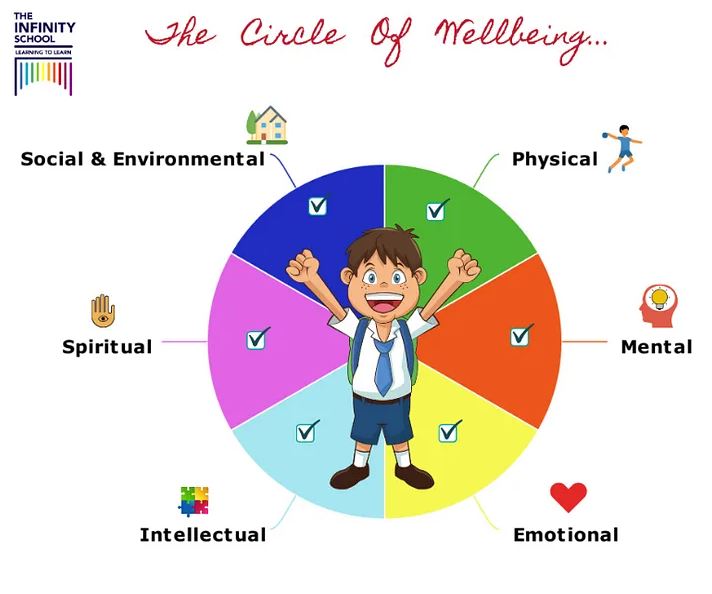Pupil Wellbeing: How to support your child?

"EVERYONE TO EXCEL THROUGH PRIDE AND AMBITION"
Elements Of Child Wellbeing: Understanding The Role Played By Schools In Child Development
1. Physical Wellbeing
Kids need more opportunities to stay active! Free play, cycling, swimming, skipping, running, team sports, etc., keep them fit & healthy. It boosts their confidence, cooperation & coordination. Structured sports programme followed in schools develops physical agility, flexibility, core strength, and a healthy lifestyle. It also promotes core values like integrity, reliability, excellence, etc., and builds a strong belief system.
2. Mental Wellbeing
Good mental health affects the emotional, behavioural, and cognitive responses of an individual. It’s more than just relieving stress. Mental wellbeing is closely related to nutritious food, physical fitness & proper sleep, which is why schools stress on good eating habits, sports, and a healthy lifestyle. They promote stress management with relaxation exercises, deep breathing, etc., to help kids manage their thoughts.
When a child is mentally strong, he/she can:
- Cope with challenges
- Bounce back from stress and negative emotions
- Fulfill his/her goals
- Enjoy life to the fullest
- Develop the capacity to build and maintain relationships
3. Emotional wellbeing
Recognising, understanding, and talking about social inhibitions & complex emotions — all of it comes under emotional wellbeing. Learning to express emotions and reaching out for help when required are valuable lessons that schools pass on to students.
When parents and teachers listen to the child and are attentive to his/her emotional needs, they can provide appropriate support, advice & assurance to them. It may prevent situations leading to bullying, school violence, suicides & other cases of verbal or emotional abuse.
Valuing and acknowledging ideas, asking questions, modelling positive emotions & good behaviour are some examples through which students are motivated to make positive changes in life.
4. Intellectual Wellbeing
Learning outside of classrooms is as important as learning inside them. Cognitive or intellectual wellbeing covers repeated trials-and-errors that ultimately lead to excellence and a sense of accomplishment — both important to lead a happy & satisfactory life.
Schools promote intellectual wellbeing through child counselling and giving structured feedback on academic and co-curricular activities. It motivates students to redress their mistakes, overcome weaknesses, and work towards improvement.
5. Spiritual Wellbeing
Spirituality has different connotations, but it is broadly defined as the process of self-discovery. It helps individuals find a purpose and meaning in life. Spirituality affects our everyday decisions. A spiritual person connects with the universe and learns to cope with intense experiences.
Being present and anchored to their surroundings (mindfulness), makes children more aware of their feelings, thoughts & surroundings. Yoga, 2-minute meditation breaks & reflective challenges help them understand their thoughts, aspirations, and goals more clearly.
6. Environmental & Social Wellbeing
When it comes to socio-emotional development, it’s not just home that matters. Kids perceive the world differently. Animals could be best friends, the bed becomes a castle, and worn-out items their treasure. Surroundings greatly impact their perceptions.
Collective efforts of family, friends & teachers can positively shape a child’s life. A probable good start is choosing the right school for our kids and supporting them together. Together, we can all make a real difference!
